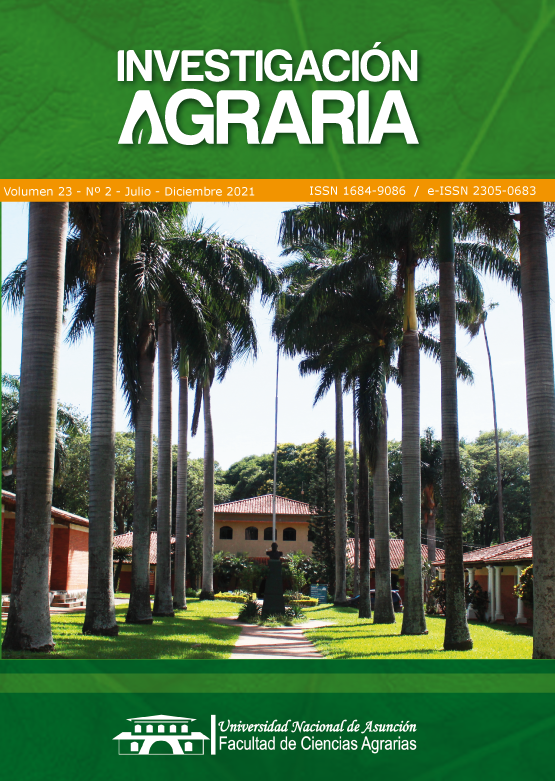Determination of the spatial behavior of anthracnose in avocado cultivation using spatial statistics
DOI:
https://doi.org/10.18004/investig.agrar.2021.diciembre.2302697Keywords:
Colletotrichum gloeosporioides, Kriging, aggregation, avocadoAbstract
Anthracnose is a fungal disease that is present in avocado crops on a recurring basis, generating significant economic losses for the productive sector of the State of Mexico. To focus control measures, it is important to know the spatial distribution and dynamics that diseases such as anthracnose follow through geostatistical methods. For this reason, the objective of this study was to determine the spatial behavior of anthracnose in the Hass avocado crop in Coatepec Harinas and Tenancingo, two producing municipalities in the State of Mexico. Four hectares were sampled, establishing 40 quadrants in each one, and in each one of them, 10 10-year-old Hass avocado trees were georeferenced with a DGPS and used to measure the incidence of anthracnose symptoms in 12 fruits. The data were analyzed with the Variowin 2.2 software and the maps generated with the Surfer 16 program. The maps produced show aggregation centers, and the semivariograms suggest a distribution fitted mostly to Gaussian and exponential models; with ranges fluctuate between 12 and 56 meters, indicating an association between the data; the highest percentage of infected surface was 99% for the first sampling in April, while for the first sampling in November, the highest percentage was 98% in both municipalities. The distance index for the regularity Ia corroborated the existence of aggregation foci in all samplings, as well as the values obtained from the clustering index Ja.Downloads
Metrics
References
Alfaro Espino, E., Morales García, J. L. & Pedraza-Santos, M. E. (2017). Hongos asociados al síndrome de la roña del aguacate en el estado de Michoacán, México. En Memorias del IV Congreso Latinoamericano del Aguacate, 04-07 de setiembre 2017, pp. 1-9. Michoacán,México: Universidad Michoacana de San Nicolás de Hidalgo.
Figueroa-Figueroa, D. K., Dávila, J. F. R., Antonio-Némiga, X. & Huerta, A. G. (2020). Cartografía del aguacate en el sur del estado de México mediante tratamiento digital de imágenes sentinel-2. Revista Mexicana de Ciencias Agrícolas, 11(4), 865-879.
FAO. (2020). Análisis del mercado de las principales frutas tropicales. Food and Agriculture Organization. http://www.fao.org/faostat/es/#home
Lemus-Soriano, B. A. & Pérez-Aguilar, D. A. (2017). Manejo de la antracnosis del aguacate con biofungicidas. En Memorias del IV Congreso Latinoamericano del Aguacate, 04-07 de setiembre 2017, pp. 1-5. Michoacán, México:Universidad Michoacana de San Nicolás de Hidalgo.
Martínez-Martínez, N., Ramírez-Dávila, J. F., Lara-Vázquez, F. & Figueroa-Figueroa, D. K. (2021). Spatial distribution of dwarf mistletoe in Monarch Butterfly Biosphere Reserve. Colombia Forestal, 24(2), 65-81.
Morales-García, J. L. (1996). Caracterización cultural, morfológica, patogénica y molecular de Colletrotrichum gloeosporioides Penz. Causante de la antracnosis del aguacate en Michoacán. (Tesis de Maestría). Montecillo, Estado de México, México : Colegio de Postgraduados, 96 p.
Morales G. J. L., Guzmán, M. D. P. R., Rivero, H. S. A. & Santos, M. E. P. (2009). Modelo para la estimación del área del fruto en la evaluación de la antracnosis en aguacate (Persea americana Mill.) cv. Hass. Revista Científica UDO Agrícola, 9(2), 421-424.
Oliver, M. & Webster, R. (1998). How geostatistics can help you. Soil Use Manag., 7, 206-217.
Perry, N. & Klukowsky, Z. (1997). Spatial distributions of counts at the edges of sample areas. En VI Conferencia de la Sociedad de Biometría. Córdoba, España.
Reina-Noreña J., Mayorga-Cobos M. J., Caldas-Herrera S. J., Rodríguez-Valenzuela J. & Varón-Devia E. H. (2015). El problema de la peca en cultivos de aguacate (Persea americana Mill.) del norte del Tolima, Colombia. Corpoica CiencTecnol Agropecu., 16(2), 265-278.
Rivera Martínez, R., Ramírez Dávila, J. F. & Acosta Guadarrama, A. (2018). Distribución espacial de las poblaciones de huevos de Bactericera cockerelli Sulc. en el cultivo de tomate de cáscara (Physalis ixocarpa Brot.). Acta Universitaria., 28, 24-33. 10.15174/au.2018.1944.
Rivera Martínez, R., Ramírez Dávila, J. F., Martínez Quiroz, M. & González Huerta, A. (2020). Spatial modeling of Bactericera cockerelli Sulc. nymphs on husk tomato (Physalis ixocarpa Brot.) using of geostatistical techniques.Biotecnia, 22 (1), 142-152. Disponible en: https://doi. org/10.18633/biotecnia. v22i1.1162
Surface Mapping System, Golden Software Inc. 809. (2002). 14th Street. Golden, Colorado 80401-1866. USA.
Sánchez-Pale, J. R., Ramírez-Dávila, J. F., González-Huerta, A. & de León, C. (2015). Patrón espacial del carbón de la espiga del maíz en diferentes localidades del Estado de México. Revista Mexicana de Ciencias Agrícolas, 6 (7),1467-1480.
Trinidad Ángel, E., Ascencio Valle, F., Ulloa, J., Ramírez Ramírez, J., Ragazzo Sánchez, J., Calderón Santoyo, M. & Bautista Rosales, P. (2017). Identificación y caracterización de Colletotrichum spp. causante de antracnosis en aguacate de Nayarit, México. Revista Mexicana de Ciencias Agrícolas (19), 3953-64.
Valbuena-García, A. M. & Rodríguez-Villamizar, L. A. (2018). Análisis espacial en epidemiología: revisión de métodos. Rev Uni Ind Santander Salud, 50 (4), 358-365. Disponible en: http://dx.doi.org/10.18273/revsal.v50n4-2018009
Vivas, L. E. & Notz, A. (2011). Distribución espacial en poblaciones de Oebalus insularis Stal (Hemiptera: Pentatomidae) en el cultivo de arroz en Calabozo, estado Guárico, Venezuela. Revista Científica UDO Agrícola, 11 (1),109-125.
Zamora, F. I. M., Dávila, J. F. R., Arriaga, M. R., Némiga, X. A. & Díaz, A. V. L. (2016). Distribución espacial de trips en aguacate en Coatepec Harinas, Estado de México. Revista Mexicana de Ciencias Agrícolas, 7, 845-856.
Published
How to Cite
Issue
Section
License
Copyright (c) 2021 Atenas Tapia Rodriguez, José Francisco Ramírez Dávila, Jesús Gaudencio Aquino Martínez, Martín Rubí Arriaga, Alfredo Ruiz Orta

This work is licensed under a Creative Commons Attribution 4.0 International License.
All content in this journal is under Creative Commons Attribution License.









 All content in this journal is under
All content in this journal is under 